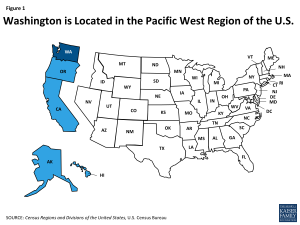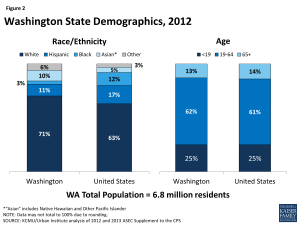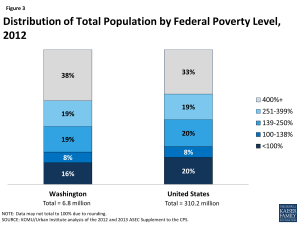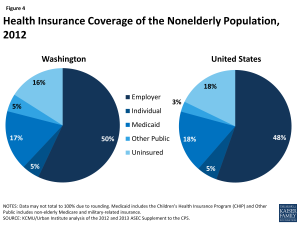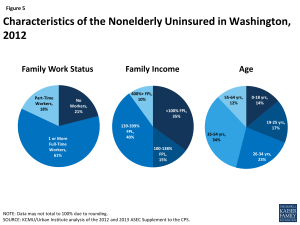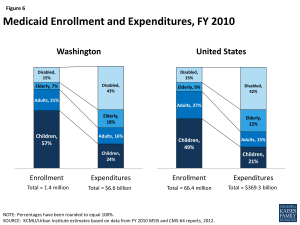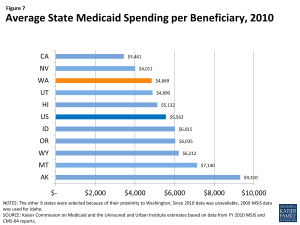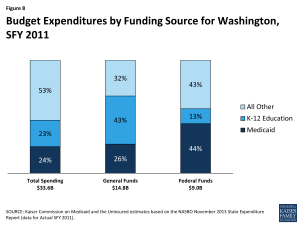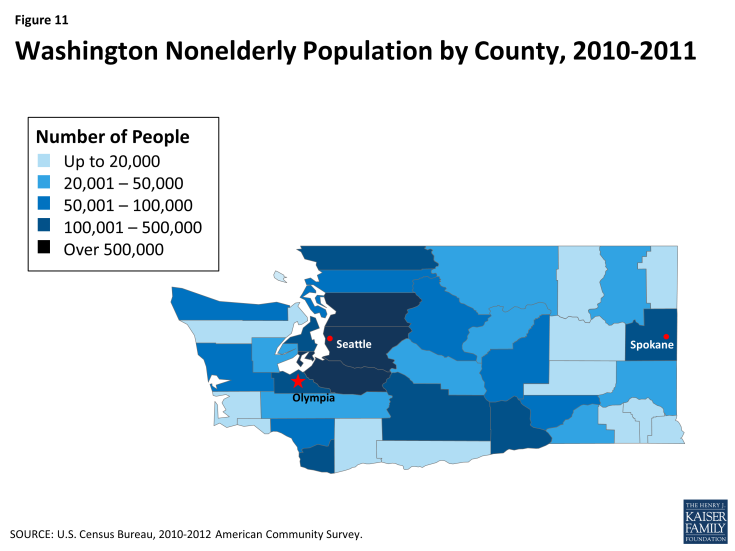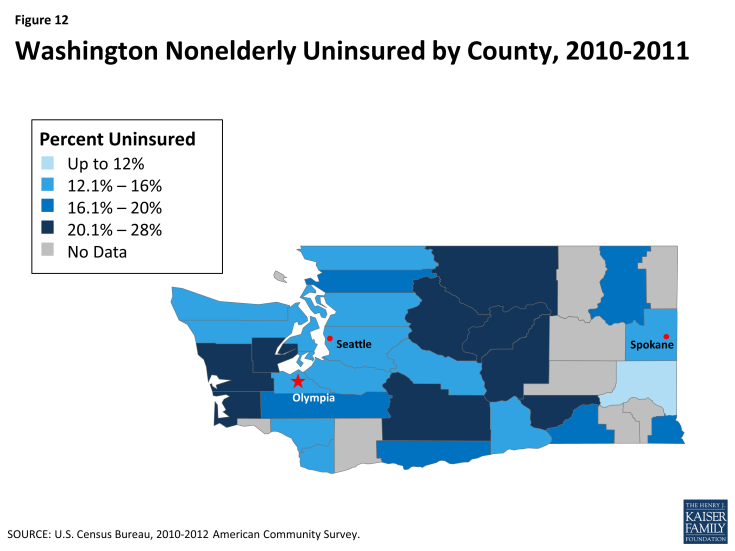The Washington State Health Care Landscape
The Affordable Care Act (ACA) went into full effect on January 1, 2014, ushering in health insurance reforms and new health coverage options in Washington and across the country. As Washington expands health coverage throughout the state, it is also at the forefront of efforts to increase health systems integration and improve health care data collection. This fact sheet provides an overview of population health, health coverage, and health care delivery in Washington in the era of health reform.
Demographics
Washington is home to 6.8 million people, making it the 13th most populous state in the U.S.1 At over 66,500 square miles, Washington is the 20th largest state and ranks 25th in population density.2 As the north-western most state of the contiguous U.S., Washington is one of five states located in the country’s Pacific West region (Figure 1).3 Washington’s topography is diverse. The state is home to numerous mountain ranges, including the Olympic Mountains in the northwest, the Rocky Mountains in the northeast, and the Cascade Mountains, which have active volcanoes, including Mt. Rainier and Mt. St. Helens, and run from north to south across the state. The Columbia Plateau is in the center of the state and extends south to the Columbia River and Puget Sound in the northwest provides access to the Pacific Ocean.4
Washington’s population is concentrated in the state’s urban areas. As of July 2012, over 50% of Washington’s population lived in 3 urban counties (King, Pierce, and Snohomish) and 29% of state residents live in the Seattle metro area.5 (See Figure 11 in the Appendix for Washington’s nonelderly population by county.) Washington’s unemployment rate in October 2013 was 7%, slightly lower than the U.S. average of 7.3%.6
Washington residents are more likely to identify as White or Asian, Native Hawaiian, or other Pacific Islander and less likely to identify as Hispanic or Black than U.S. residents as a whole. Seven in ten (71%) Washington residents identify as White, compared to 11% who identify as Hispanic, 10% who identify as Asian, Native Hawaiian, or other Pacific Islander, and 3% who identify as Black (Figure 2).7 Washington is also home to over 69,000 American Indians and Alaska Natives, who account for 1% of the state population.8 Ninety-two percent of Washington’s residents are U.S. citizens.9 The age distribution of Washington’s population aligns with that of the U.S. overall, with more than 6 in 10 (62%) residents between the ages of 19-64.10 One in six (16%) of individuals in Washington are living in poverty (have income below 100% of the federal poverty level (FPL) or $11,670 for an individual, $19,790 for a family of 3 in 2014) and more than 6 in 10 (62%) have family income levels below 400% FPL that qualify them for either Medicaid or premium subsidies in the state Health Insurance Marketplace under the ACA (Figure 3).
However, poverty rates vary by race/ethnicity and age. Twelve percent of those who identified as White were living in poverty in 2012, compared to 35% of those who identified as Black and 28% of those who identified as Hispanic. In addition, among children under age 19, one-fifth (20%) were living in poverty, while only 15% of adults age 19-64 and 9% of adults age 65 and over were living in poverty.11
State Economy
Washington’s economy is growing steadily, despite state budgetary challenges. In 2012, Washington’s Gross Domestic Product (GDP) was $375.7 billion, making it the 14th largest economy in the U.S.12 Like many other states across the country, Washington experienced an increase in its real GDP from 2011 to 2012 and Washington was among the 10 states that experienced the largest percentage increase to its state economy that year.13 Computer software development (Microsoft and Nintendo), online retailers (Amazon and Expedia), and aircraft construction (Boeing) are major industries in the state, as well as lumber and wood production (Weyerhaeuser), agriculture, and tourism.14 Like other states across the country, Washington experienced budgetary challenges during the recent economic downturn and the Washington State Economic and Revenue Forecast Council is projecting a $1.3 billion budget shortfall for the 2013-2015 state budget cycle, up from previous projections of $900 million due to higher than anticipated Medicaid enrollment.15
Population Health
Overall population health in Washington is ranked above the national average. Washington ranked 14 among the 50 states for total population health in the United Health Care Foundation’s report, America’s Health Rankings 2013.16 Compared to other states across the country, Washington has a low prevalence of both obesity and diabetes among adults, and fewer deaths due to heart disease.17,18,19 In addition, the share of adults who smoke in Washington is smaller than the U.S. overall.20 However, the percentage of adults who report poor mental health in Washington is higher than in many states across the country, as is the prevalence of asthma among adults and the incidence of invasive cancer. 21,22,23
Disparities in health and health care access exist in Washington. Like other states across the country, measures of health status in Washington vary by race/ethnicity and patterns across these measures in Washington are similar to national averages. Eighty-seven percent of those who identify as White report being in very good or excellent health, compared to 77% of Blacks, 73% of American Indian or Alaska Natives, and 69% of Hispanics.24 Also, while the rates of overweight and obesity statewide are low, those who identify as American Indian or Alaska Native (79%), Black (76%), or Hispanic (69%) are more likely to be overweight or obese than those who identify as White (61%) or Asian, Native Hawaiian, or other Pacific Islander (42%).25 In addition, those who identify as Black (44%) and White (42%) are more likely to report mental health issues, compared to those who identify as Asian, Native Hawaiian, or other Pacific Islander (33%), or Hispanic (26%).26 The rates of reported mental health issues in Washington are higher than national averages across these racial and ethnic groups, except for Hispanics.27
Disparities in access to care also exist in Washington. For example, while 75% of those who identify as White and 71% of those who identify as Asian, Native Hawaiian, or other Pacific Islander report having a usual source of care, the rate is only 63% for Blacks and American Indians and Alaska Natives, and 46% for Hispanics.28
State and local efforts to reduce health disparities are underway. In 2006, Washington’s Legislature established the Governor’s Interagency Council on Health Disparities under Governor Christine Gregoire. The Interagency Council develops annual action plans and convenes advisory committees to address racial/ethnic and gender-based health disparities in the state.29 In 2009, the Washington State Board of Health adopted a five-year strategic plan with five goals to reduce health disparities.30 In addition, the King County Department of Health operates the Seattle and King County REACH coalition, which works to reduce the prevalence of diabetes in King County among communities of color.31
Coverage
Nearly 948,000 people, or 16% of Washington’s nonelderly adults and children, were uninsured in 2012 (Figure 4).32 This rate is similar to the national average of 15%, which reflects the range of uninsured rates across the country from 4% in Massachusetts to 24% in Texas. As shown in Figure 12 (Appendix), the nonelderly uninsured in Washington are not equally distributed across the state’s counties, with the central counties east of the Cascade Mountains and the West Coast south of the Olympic Mountains having higher uninsured rates than other areas of the state. As in other states across the U.S., the majority of the nonelderly uninsured in Washington have at least one full-time worker in their households, have income below 400% of the FPL, and are under age 55 (Figure 5).33 Nearly 6 in 10 (57%) of nonelderly uninsured Washingtonians identify as White, nearly one-quarter (22%) identify as Hispanic, 10% identify as Asian, Native Hawaiian, or other Pacific Islander, and 5% identify as Black.34
Among the 86% of Washingtonians with health insurance, the largest share (50% of the state population) have employer-sponsored coverage, followed by Medicare (16%), Medicaid (13%), and private individual insurance (5%)(Figure 4).35
Medicaid
Similar to the national picture, the large majority of Medicaid enrollees in Washington are children, but the elderly and individuals with disabilities account for most spending on Medicaid. Based on data for Fiscal Year (FY) 2010 (the latest year available to compute spending by group), 57% of Medicaid, known in the state as Apple Health, enrollees were children, who accounted for 24% of expenditures (Figure 6).36 About 1 in 5 enrollees (22%) were elderly or people with disabilities, who accounted for 61% of total program costs. Average spending per beneficiary was $4,849, less than the national average of $5,563 and less than most nearby states (Figure 7).37
Medicaid costs are shared by the state and the federal government, with the federal government paying 50% of the cost of Washington Medicaid; therefore, for every $1.00 that Washington spends on Medicaid, the federal government sends an additional $1.00 to the state in matching funds.38 Washington provides coverage to children up to 317% FPL through a separate CHIP program, for which the federal government pays 65% of the cost.39 The combined federal and state spending on Medicaid in Washington for FY 2011 was $7.6 billion, a growth of one billion from FY 2010 that was largely attributable to the transition of many enrollees from the state-funded Basic Health Plan to Medicaid, which enabled the state to draw down new federal matching funds (discussed in more detail below). Federal and state spending on Washington Medicaid then remained relatively stable at $7.6 billion for FY 2012.40 In State Fiscal Year (SFY) 2011, Medicaid accounted for 24% of total state spending, 26% of state general fund spending, and 44% of state spending of federal funds (Figure 8).41 Medicaid is the second largest source of state general fund spending, behind elementary and secondary education, but the largest source of federal revenue flowing into the state.
Nearly all Medicaid beneficiaries in Washington are enrolled in managed care. Nearly 9 out of 10 (88%) Medicaid enrollees in Washington are enrolled in a managed care arrangement.42 Apple Health contracts with five commercial managed care organizations, to provide comprehensive health services, and eleven regional support networks (10 county plans and 1 private plan), to provide mental health services. Enrollment into managed care arrangements is growing nationwide and, in 2011, Washington was one of 23 states where at least 80% of Medicaid enrollees were enrolled in managed care.43
Washington has implemented a health home initiative for Medicaid beneficiaries with chronic conditions, including dual eligible beneficiaries. In July 2013, Washington began the phasing in its health home initiative across six coverage areas for beneficiaries who have one chronic condition and are at risk for developing another.44 Washington selected Health Home Lead entities to implement the health home initiative and contract with Care Coordination Organizations to provide health home services, such as care coordination and case management. Washington’s health home initiative covers a broad range of chronic conditions and services are provided on a fee-for-service basis or in a managed care system, depending on the Lead Entity. Fee-for-service health homes have a three-tiered payment methodology and are reimbursed based on their levels of outreach and consumer engagement activities, the ratio of providers to beneficiaries, and the ratio of telephone to face-to-face beneficiary encounters. All of these costs are built into the overall capitation rate for managed care health homes. Washington is providing all health homes with access to its Predictive Risk Intelligence System (PRISM), which is a secure, web-based clinical support tool that uses predictive modeling to help identify clients most in need of care coordination. PRISM is intended to complement provider electronic health records and the state’s health information exchange, OneHealthPort. As of October 2013, health homes were operating in all areas of the state, except King and Snohomish counties, which are two of the three most populous counties in the state and where nearly 30% of the state’s high-risk Medicaid beneficiaries reside.45
Washington is seeking to better coordinate care and control costs for its dual eligible beneficiaries, who often have complex and costly health care needs. In 2010, Washington had nearly 172,000 dual eligible individuals, who made up 13% of total state Medicaid enrollment and accounted for 32% of total state Medicaid costs.46 In an effort to better integrate care and align financing for these beneficiaries, CMS is using new authority afforded under the ACA to launch demonstration projects in several states across the country that test new care coordination and delivery models. Washington is one of 11 states approved to participate in the duals demonstration projects.47
Two duals demonstration projects were approved by CMS for Washington, one using capitated managed care model for dual eligible beneficiaries in two urban counties, King and Snohomish, and the other using a managed fee-for-service model for high-risk, high-cost adult dual eligible beneficiaries in the state’s other 37 counties.48 Washington’s managed fee-for-service demonstration, which builds off of the state’s health home model, began enrolling 21,000 beneficiaries in July 2013. Beneficiaries are automatically enrolled in a health home initiative, but choose whether to receive Medicaid health home services; their other Medicare and Medicaid services continue on a fee-for-service basis. The state will retroactively share in any savings from the managed fee-for-service demonstration with CMS if savings and quality benchmarks are met. The state’s capitated managed care demonstration will begin enrolling 27,000 beneficiaries in July 2014. Participation in this demonstration is voluntary for eligible beneficiaries, although they will be auto-enrolled into one of the plans, unless they take action to affirmatively opt-out. Savings are deducted prospectively from CMS and the state’s contributions to the Medicare and Medicaid baseline capitated rates, according to the state’s Memorandum of Understanding with CMS.
Health Reform
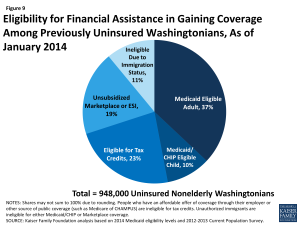
Figure 9: Eligibility for Financial Assistance in Gaining Coverage Among Previously Uninsured Washingtonians, As of January 2014
The ACA could extend coverage to nearly 950,000 uninsured Washingtonians. A main goal of the ACA is to extend health coverage to many of the 47 million nonelderly uninsured individuals across the country, including 948,000 uninsured Washingtonians. The ACA accomplishes this through insurance reforms and by establishing new coverage pathways, including an expansion of Medicaid to cover nearly all nonelderly individuals up to 138% of the FPL ($16,105 for an individual, $27,310 for a family of 3 in 2014), and by providing premium tax credits to many individuals between 100% – 400% FPL to purchase coverage on the Health Insurance Marketplaces (Figure 9). As a result of the Supreme Court decision on the ACA, the Medicaid expansion is now effectively a state option.49 Washington is one of 26 states and DC implementing the ACA Medicaid expansion.50 Among previously uninsured adults, nearly four in 10 (37%) will be eligible for Medicaid and nearly one in four (23%) will be eligible for premium tax credits under the ACA.51
Washington expanded health coverage prior to the ACA through a state-funded Basic Health Plan. In 1987, Washington began extending coverage to certain groups of low-income adults and children through a state-funded managed care program pilot called the Basic Health Plan (BHP).52 Over the following decades, the BHP was extended statewide and became a health coverage plan for tens of thousands of low-income, working adults with incomes below 200% FPL, who were ineligible for Medicaid.Washington’s BHP became the model for the Basic Health Program under ACA.53 Enrollment into Washington’s BHP continued to grow through the mid-90’s and reached its enrollment cap of 130,000 in 2003. Coverage levels remained at roughly 100,000 through 2008.54 However, amid state budget pressures during the recent economic downturn, Washington cut BHP funding by 43% in its 2009 – 2011 State Budget and there were plans to eliminate the program all-together.55 As a result of the funding cuts, Washington dramatically cut the number of BHP beneficiaries and closed the program to new enrollees. Meanwhile, the waiting list for the BHP continued to grow and had surpassed 150,000 in 2011.56 Despite continued program pressures, the BHP remained in effect until Washington received approval of their Section 1115 Medicaid waiver and was able to transition many enrollees to Medicaid.57
Medicaid Expansion
Washington received a Medicaid waiver to both get a head start preparing for the ACA Medicaid expansion and maintain coverage for many low-income residents. Washington was one of seven states (including DC) using new authority under the ACA or a Medicaid waiver to expand Medicaid coverage early to many low-income adults eligible for coverage under the ACA, beginning in January 2014.58 CMS approved Washington’s Section 1115 “Transitional Bridge” Medicaid Demonstration waiver, which was in effect from January 1, 2011 to December 31, 2013, to maintain coverage for nonelderly adults up to 133% FPL who were enrolled in the state-funded BHP or the state Alcohol and Drug Addiction Treatment Support Act programs, providing them access to primary, acute, and mental health care until the ACA went into full effect.59 Enrollment under the waiver was capped, with annual enrollment targets of 43,300, and individuals were subject to cost-sharing that exceeded normal Medicaid limits. By January 1, 2014, enrollees under the Transitional Bridge program were transitioned to Medicaid coverage under the ACA, which is not capped and has lower beneficiary cost-sharing. In addition, the state receives an enhanced federal match rate for both enrollees transferred from the Transitional Bridge program and newly eligible beneficiaries under the Medicaid expansion.
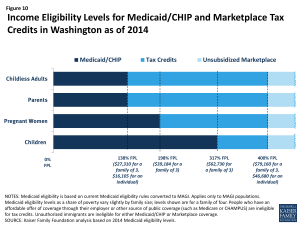
Figure 10: Income Eligibility Levels for Medicaid/CHIP and Marketplace Tax Credits in Washington as of 2014
Washington has had high Medicaid enrollment and has surpassed its 2018 Medicaid enrollment goals. As of March 31, 2014, 423,221 new individuals (not previously on Medicaid) had signed up for Medicaid in Washington, including over 285,000 newly eligible adults since October 1, 2013, which surpasses the state’s 2018 Medicaid enrollment goal of one-quarter of a million enrollees.60,61 In addition, Washington processed nearly 417,000 Medicaid renewals and redeterminations during the same time period.62 As of January 1, 2014, the Medicaid eligibility levels in Washington are 317% FPL for children, 198% FPL for pregnant women, and 138% FPL for parents and other adults (Figure 10).63 To prepare for the anticipated surge in enrollment and to make the enrollment process easier for consumers, Washington integrated its online Medicaid and Marketplace systems and all individuals submit online applications for coverage and Medicaid renewals through the Marketplace web portal. Individuals can also apply for coverage in person, over the phone, and by mail. Medicaid does not have an open enrollment period, so eligible individuals may continue to sign up throughout the year.
Health Insurance Marketplace
Washington is one of 17 states operating a state-based Health Insurance Marketplace.64 On May 11, 2011, Governor Gregoire signed Senate Bill 5445 into law establishing the Washington Health Benefit Exchange.65 Washington is operating a state-based Marketplace, called Washington Healthplanfinder, which is governed by an 11-member board and operates as a self-sustaining public-private partnership that is separate and independent from the state.66 Washington was awarded $266 million in federal grant funds to assist with the establishment of their state-based Marketplace, including a nearly $1 million Exchange Planning Grant and $265 million in Exchange Establishment Grants.67
In February 2013, Washington’s Marketplace released guidance for Qualified Health Plans participating in Healthplanfinder.68 To assist consumers in comparing across plans, the Board also approved nine consumer rating factors that evaluated plans based on enrollee satisfaction, provider reimbursement, and promotion of primary care.69 Eight insurance carriers are offering 46 Qualified Health Plans in Washington’s Marketplace.70 At $283 per month, Seattle has the 18th highest monthly premium for a Benchmark Health plan among major cities across the country, before subsidies.71
Washington’s Marketplace established partnerships with groups and organizations throughout the state to help with consumer outreach and assistance. The Marketplace awarded $6 million in grant funding to ten entities to serve as Lead Organizations for the state’s In-person Assistance program and $420,000 in grant funding to five organizations as part of its Tribal Assister Program.72,73,74 The Lead Organizations are responsible for building, training, and managing a network of partners in their region to conduct in-person education and enrollment assistance. As of October 2013, they had trained 1,100 In-person Assisters and partnered with nearly 100 community organizations, including eight Outreach Partners, across the state.75 Washington Healthplanfinder also trained more than 1,000 registered brokers to assist with Marketplace outreach and enrollment.76
Washington’s Marketplace also invested heavily in advertising and consumer outreach activities. The Marketplace’s consumer education campaign targeted consumers through a variety of avenues, including grassroots activities, social media, and business outreach. Healthplanfinder advertisements appeared on television, radio, print, billboards, buses, and in other public areas. In August 2013, Marketplace began an online advertising campaign to build Healthplanfinder brand awareness and, in September, launched a campaign to explain how consumers could use the online portal to compare plans and enroll into coverage.77 The Marketplace produced an eight-part “Countdown to Coverage” webinar series to educate consumers on the ACA, how Healthplanfinder works, and the coverage options available in 2014.78 The Marketplace also partnered with a national nonprofit, The Young Invincibles, to develop a free smartphone application that provides information about the ACA and targets young adults.79
Starting October 1, 2013, Washington’s Marketplace held a series of outreach and enrollment events throughout the open enrollment period, including a mobile enrollment tour featuring a customized Washington Healthplanfinder bus.80 The bus made stops at nine mobile enrollment event locations throughout the state, and IPAs used laptops to enroll consumers on-site.
To assist individuals who speak languages other than English, Washington’s Marketplace materials and consumer assistance services are available in multiple languages. The Washington Healthplanfinder website is fully translated into Spanish and informational materials are available to consumers in 7 different languages (Cambodian, Chinese, Korean, Laotian, Russian, Somali, Spanish, and Vietnamese) other than English. In addition, beginning October 1, 2013, Washington Healthplanfinder customer call center representatives had access to a language line with translation capabilities for 175 different languages and bilingual English-Spanish speakers on staff, to assist with eligibility determinations and marketplace plan enrollment.81
Washington had successful Marketplace plan enrollment during the first open-enrollment period. During the first open-enrollment period, 163,207 individuals enrolled in and paid for Marketplace coverage through the Washington Healthplanfinder.82 With over 32% of their potential Marketplace population enrolled, Washington has the 10th highest percent of eligible individuals enrolled among the states.83
Delivery System Reform
Washington is working to better coordinate and integrate care through delivery system reform initiatives. In February 2013, Washington was awarded a 6-month $1 million State Innovation Model Pre-Testing Award Grant by CMS to develop a comprehensive State Health Care Innovation Plan (SHCIP).84 Washington’s SHCIP builds off of existing quality, community health, and health prevention collaboratives to create an aligned, person-centered, primary care-focused health system that both increases care quality and reduces costs.85 To achieve this, Washington’s SHCIP creates a virtual Accountable Care Organization (ACO) that coordinates care both among primary care providers and specialists and among health care facilities. In addition, the state’s SHCIP works to align financing and payment systems in order to support integrated medical and behavioral health and supports the use of evidence-based strategies to improve care quality.
Washington will also select up to 10 communities throughout the state to receive Community of Health Planning Grants, authorized through House Bill 2572, as part of the state efforts to advance value-based purchasing, promote community health, and increase integration of needed social supports for individuals with chronic illness.86
Safety Net
Washington’s safety net delivery system will continue to play an important role in providing health care to the state’s vulnerable population. Washington’s community health centers and hospitals provide access to needed primary, preventive, and acute care series for low-income and underserved residents. Washington is home to 25 federally qualified health centers (FQHCs) that operate 243 sites throughout the state.87 In 2012, the state’s FQHCs saw 819,000 patients, 35% of whom were uninsured and 44% of whom had Medicaid.88 Nearly 7 in 10 (68%) health center patients in 2011 had incomes below 100% FPL.89,90 The Department of Health and Human Services awarded Washington’s FQHCs $5.2 million for FYs 2013 and 2014 to assist with outreach and enrollment under the ACA.91
Harborview Medical Center is the state’s main safety net hospital serving Seattle and the surrounding areas and is the only designated Level 1 adult and pediatric trauma and burn center in the state.92 In FY 2012, Harborview provided $210 million in uncompensated care. To provide additional help to hospitals that serve a high number of uninsured and underinsured patients, the federal government sends states Disproportionate Share Hospital (DSH) payments. In FY 2013, Washington received over $194 million in federal DSH payments and in FY 2014, it is anticipated to receive $197 million in DSH payments.93 DSH payments are slated to be scaled back under the ACA, which has prompted some hospital and health centers to establish new partnerships and to collaborate to operate clinics with extended hours, to which individuals who show up to Emergency Departments with non-emergent medical conditions can be diverted.94
Despite Washington’s existing safety net, there are Health Professional Shortage Areas (HPSAs) and unmet need for care. As of July 2013, Washington had 147 primary care HPSAs and only 47% of the primary health care need in the state was being met.95 The state had 112 mental health and 107 dental HPSAs, and only 40% of the need for mental health care services and 28% of the need for dental services was being met.96 Washington is one of 17 states that allows nurse practitioners to practice with full autonomy.97
Looking Ahead
There is much to watch in Washington moving forward. Individuals who have newly gained coverage under the Medicaid expansion or the state Marketplace are beginning to interact with their new health plans and providers. Washington is working to transform its health care delivery and payment system through its health home initiative, SHCIP, and local planning grants and collaboratives. In addition, Washington’s focus on advanced data reporting and analytics will likely allow stakeholders and policy leaders to receive timely data and begin to analyze the impact of the ACA and other health policy changes on the health, health care access, and health care utilization of Washingtonians now and in the future.
Appendix
Endnotes
Urban Institute and Kaiser Commission on Medicaid and the Uninsured estimates based on the Census Bureau's March 2012 and 2013 Current Population Survey (CPS: Annual Social and Economic Supplements).
World Atlas, United States, http://www.worldatlas.com/aatlas/infopage/usabysiz.htm.
U.S. Department of Commerce, Economics, and Statistics Administration, Census Regions and Divisions of the United States (U.S. Census Bureau), http://www.census.gov/geo/maps-data/maps/pdfs/reference/us_regdiv.pdf.
World Atlas, Washington: Geography, http://www.worldatlas.com/webimage/countrys/namerica/usstates/waland.htm.
U.S. Census Bureau, Annual Estimates of the Resident Population: April 1, 2010 to July 1, 2013 (March 2014).
Washington and state figures from Table 3, Regional and State Employment and Unemployment: October 2013, and Unemployment rates by State, seasonally adjusted: October 2012 and 2013, Bureau of Labor Statistics, available at http://www.bls.gov/news.release/laus.t03.htm. U.S. figure from Bureau of Labor Statistics, available at http://data.bls.gov/cgi-bin/surveymost?bls
UI/KCMU estimates based on March 2012 and 2013 ASEC Supplement to the CPS.
UI/KCMU estimates based on March 2012 and 2013 ASEC Supplement to the CPS.
UI/KCMU estimates based on March 2012 and 2013 ASEC Supplement to the CPS.
UI/KCMU estimates based on March 2012 and 2013 ASEC Supplement to the CPS.
UI/KCMU estimates based on March 2012 and 2013 ASEC Supplement to the CPS.
Bureau of Economic Analysis, Gross Domestic Product by State 2012 (June 6, 2013).
Bureau of Economic Analysis, Widespread Economic Growth in 2012 (June 6, 2013), http://www.bea.gov/newsreleases/regional/gdp_state/gsp_newsrelease.htm.
Washington State Economic and Revenue Forecast Council, April Economic & Revenue Update (April 10, 2014), http://www.erfc.wa.gov/publications/documents/apr14.pdf.
Washington State Economic and Revenue Forecast Council, Budget Outlook (May 2014), http://www.erfc.wa.gov/forecast/budgetOutlook.shtml.
United Health Care Foundation, America’s Health Rankings: State Ranking Overview: 2013 (2013), http://www.americashealthrankings.org/rankings.
Obesity: 62.3% of adults in Washington were overweight or obese, compared to a national average of 62.4%. Washington has the 16th lowest rates of overweight and obesity among adults across the U.S. (KCMU analysis of the Center for Disease Control and Prevention (CDC)'s Behavioral Risk Factor Surveillance System (BRFSS) 2012 Survey Results).
Diabetes: 8.8% of Washington adults have been diagnosed with diabetes, compared to a national average of 10.2%. Washington had the 15th lowest rate of adults with Diabetes (KCMU analysis of the CDC’s BRFSS 2012 Survey Results).
Heart Disease: Washington had 151.5 deaths due to heart disease per 100,000, compared to the national average of 179.1 deaths per 100,000. Washington has the 12th lowest rates across the U.S. (The Centers for Disease Control and Prevention (CDC), National Center for Health Statistics, Division of Vital Statistics, National Vital Statistics Report Volume 61, Number 4, Table 19, May 8, 2013).
Smoking: 17.2% of adults in Washington smoke, compared to a national average of 18.8%. Washington has the 12th lowest adult smoking prevalence across the U.S. (KCMU analysis of the CDC’s BRFSS 2012 Survey Results).
Mental Health: 38.6% of adults report poor mental health in Washington, compared to a national average of 35.6%. Washington has the fifth highest percent of adults reporting poor mental health across the country (KCMU analysis of the CDC’s BRFSS 2012 Survey Results).
Asthma: 9.6% of Washington adults self-report having asthma, compared to 8.6% of adults nationally. Washington has the 16th highest asthma rate across the country (2010 Behavioral Risk Factor Surveillance System (BRFSS), Table C1, analysis by Air Pollution and Respiratory Health Branch, National Center for Environmental Health Centers for Disease Control and Prevention, available at http://www.cdc.gov/asthma/brfss/2010/brfssdata.htm).
Cancer: 483.5 per 100,000 Washingtonians have invasive cancers, compared to a national average of 459 per 100,000. Washington has the 12th highest invasive cancer rate across the U.S. (U.S. Cancer Statistics Working Group. United States Cancer Statistics: 1999-2009 Incidence and Mortality Web-based Report. Atlanta (GA): Department of Health and Human Services, Centers for Disease Control and Prevention, and National Cancer Institute; 2013).
KCMU analysis of the CDC’s BRFSS 2012 Survey Results
The rates of overweight and obesity for American Indians and Alaska Natives and Blacks are higher in Washington than the U.S. averages of 70% and 73%, respectively. KCMU analysis of the CDC’s BRFSS 2012 Survey Results
KCMU analysis of the CDC’s BRFSS 2012 Survey Results
National averages for rates of reported mental health issues are: Black (39%), White (39%), Asian, Native Hawaiian, or other Pacific Islander (30%), Hispanic (38%). KCMU analysis of the CDC’s BRFSS 2012 Survey Results.
KCMU analysis of the CDC’s BRFSS 2012 Survey Results
Governor’s Interagency Council on Health Disparities website, http://healthequity.wa.gov/ and their State Action Plan to Eliminate Health Disparities (December 2013 Update), http://healthequity.wa.gov/Portals/9/Doc/Publications/Reports/HDC-Reports-Dec-2013-Action-Plan-Update.pdf.
Washington State Board of Health, Health Disparities, http://sboh.wa.gov/OurWork/CurrentProjects/HealthDisparities.aspx.
King County Department of Health, Seattle & King County REACH Coalition: Reducing diabetes health disparities experienced by communities of color, http://www.kingcounty.gov/healthservices/health/chronic/reach.aspx.
UI/KCMU estimates based on March 2012 and 2013 ASEC Supplement to the CPS.
UI/KCMU estimates based on March 2012 and 2013 ASEC Supplement to the CPS.
UI/KCMU estimates based on March 2012 and 2013 ASEC Supplement to the CPS.
UI/KCMU estimates based on March 2012 and 2013 ASEC Supplement to the CPS.
KCMU/Urban Institute estimates based on data from FY 2010 MSIS and CMS-64 reports, 2012.
KCMU/Urban Institute estimates based on data from FY 2010 MSIS and CMS-64 reports, 2012.
Federal Register, November 30, 2012 (Vol 77, No. 231), pp 71420-71423, at http://www.gpo.gov/fdsys/pkg/FR-2012-11-30/pdf/2012-29035.pdf.
Martha Heberlein, Tricia Brooks, Joan Alker, Samantha Artiga, and Jessica Stephens, Getting into Gear for 2014: Findings from a 50-State Survey of Eligibility, Enrollment, Renewal, and Cost-Sharing Policies in Medicaid and CHIP, 2012-2013 (January 2013), http://www.kff.org/medicaid/report/getting-into-gear-for-2014-findings-from-a-50-state-survey-of-eligibility-enrollment-renewal-and-cost-sharing-policies-in-medicaid-and-chip-2012-2013/ and Federal Register, November 30, 2012 (Vol 77, No. 231), pp 71420-71423.
Urban Institute estimates based on data from CMS (Form 64), as of 8/24/12 and 9/16/13.
Kaiser Commission on Medicaid and the Uninsured estimates based on the NASBO November 2013 State Expenditure Report (data for Actual SFY 2011).
Centers for Medicare & Medicaid Services, Medicaid Managed Care Enrollment Report (November 2012), http://www.medicaid.gov/Medicaid-CHIP-Program-Information/By-Topics/Data-and-Systems/Downloads/2011-Medicaid-MC-Enrollment-Report.pdf.
State Health Facts, Medicaid Managed Care Enrollees as a Percent of State Medicaid Enrollees (State Health Facts, November 2012), https://www.kff.org/medicaid/state-indicator/medicaid-managed-care-as-a-of-medicaid/.
Washington State Health Care Authority, Health Homes, http://www.hca.wa.gov/pages/health_homes.aspx.
Washington Health Care Authority, All High Risk Medicaid Clients by County (June 2011), http://www.hca.wa.gov/documents/health_homes/HighRiskMedicaidClientsByCounty.pdf.
Kaiser Commission on Medicaid and the Uninsured and Urban Institute estimates based on data from FY 2010 MSIS, 2013, https://www.kff.org/medicaid/issue-brief/medicaids-role-for-dual-eligible-beneficiaries/
Kaiser Commission on Medicaid and the Uninsured, State Demonstration Proposals to Integrate Care and Align Financing and/or Administration for Dual Eligible Beneficiaries (Kaiser Family Foundation, April 2014), https://www.kff.org/medicaid/fact-sheet/state-demonstration-proposals-to-integrate-care-and-align-financing-for-dual-eligible-beneficiaries/. For more information, see: MaryBeth Musumeci, Financial and Administrative Alignment Demonstrations for Dual Eligible Beneficiaries Compared: States with Memoranda of Understanding Approved by CMS (Kaiser Family Foundation, April 2014), https://www.kff.org/medicaid/issue-brief/financial-alignment-demonstrations-for-dual-eligible-beneficiaries-compared/.
Washington’s memorandum of understanding for its capitated managed care demonstration: http://www.cms.gov/Medicare-Medicaid-Coordination/Medicare-and-Medicaid-Coordination/Medicare-Medicaid-Coordination-Office/FinancialAlignmentInitiative/Downloads/WACAPMOU.pdf and its managed fee-for-service final demonstration agreement: http://www.adsa.dshs.wa.gov/duals/documents/WA%20Final%20Demonstration%20Agreement.pdf.
MaryBeth Musumeci, A Guide to the Supreme Court’s Affordable Care Act Decision (Kaiser Family Foundation, June 2012), https://www.kff.org/health-reform/issue-brief/a-guide-to-the-supreme-courts-affordable/.
State Health Facts, Status of State Action on the Medicaid Expansion Decision, 2014 (March 26, 2014), https://www.kff.org/health-reform/state-indicator/state-activity-around-expanding-medicaid-under-the-affordable-care-act/.
KCMU analysis based on 2014 Medicaid eligibility levels and 2012-2013 CPS.
Washington State Legislature, Basic Health Plan – Health Care Access Act (1987), http://apps.leg.wa.gov/rcw/default.aspx?cite=70.47&full=true.
Federal Register, March 12, 2014 (79 FR 14111), pp 14111-14151, at https://federalregister.gov/a/2014-05299.
State of Washington Department of Social and Health Services, Section 1115 Medicaid Waiver Application (July 7, 2010), see Exhibit 4, http://www.hca.wa.gov/hcr/documents/waiver/1115WaiverCover7710.pdf.
Kim Justice, Cuts on the Rise, Health in Decline (Washington State Budget & Policy Center, February 2012), http://budgetandpolicy.org/reports/cuts-on-the-rise-health-in-decline. Also see: Evans School of Public Affairs, Implementing Budget Cuts in the Basic Health Plan: A Case Study (University of Washington), http://hallway.evans.washington.edu/cases/details/implementing-budget-cuts-basic-health-plan-case-study.
DJ Wilson and Amy Snow Landa, “The Basic Health Plan model may live on” (HeraldNet, February 16, 2014), http://www.heraldnet.com/article/20140216/OPINION03/140219431.
Washington maintained its state-funded BHP after approval of the 1115 waiver for some individuals not eligible for Medicaid under the ACA.
Martha Heberlein, et.al., Getting into Gear for 2014: Findings from a 50-State Survey of Eligibility, Enrollment, Renewal, and Cost-Sharing Policies in Medicaid and CHIP, 2012-2013 (January 2013). For more information, also see: Benjamin Sommers, Emily Arntson, Genevieve Kenney, and Arnold Epstein, “Lessons from Early Medicaid Expansion Under Health Reform: Interviews with Medicaid Officials,” Medicare & Medicaid Research Review vol. 3, no. 4 (2013), E1-E18, http://www.cms.gov/mmrr/Downloads/MMRR2013_003_04_a02.pdf.
Washington Section 1115 “Transitional Bridge” Demonstration Waiver approval letter, http://www.medicaid.gov/Medicaid-CHIP-Program-Information/By-Topics/Waivers/1115/downloads/wa/wa-transitional-bridge-ca.pdf.
Washington Health Benefit Exchange, Coverage Enrollment Report October 1, 2013 – March 31, 2014 (April 23, 2014), http://wahbexchange.org/files/4513/9821/1124/WAHBE_End_of_Open_Enrollment_Data_Report_FINAL.pdf.
- Washington State Health Care Authority, Washington State Doubles its Medicaid Expansion Goal (April 1, 2014), http://www.hca.wa.gov/Releases/State%20exceeds%20its%20Medicaid%20enrollment%20target%20-%20graphic.pdf and Washington Health Care Authority, “Washington State’s Apple Health (Medicaid) program reaches enrollment goals – three years early” (April 1, 2014), http://www.hca.wa.gov/Releases/Apple%20Health%20smashes%20enrollment%20target.pdf.
- Washington Health Benefit Exchange, Coverage Enrollment Report October 1, 2013 – March 31, 2014.
KCMU analysis based on CMS, State Medicaid and CHIP Income Eligibility Standards Effective January 1, 2014 (October 24, 2013).
State Health Facts. “State Decisions for Creating Health Insurance Marketplaces” (Kaiser Family Foundation, May 28, 2013), http://www.kff.org/health-reform/state-indicator/health-insurance-exchanges/.
Washington State Legislature, Senate Bill 5445 (May 2011), http://apps.leg.wa.gov/billinfo/summary.aspx?bill=5445&year=2011.
Kaiser Family Foundation, State Marketplace Profiles: Washington (October 2013), https://www.kff.org/health-reform/state-profile/state-exchange-profiles-washington/.
State Health Facts, Total Health Insurance Exchange Grants (Kaiser Family Foundation, January 2014), https://www.kff.org/health-reform/state-indicator/total-exchange-grants/.
Washington Health Benefit Exchange, Guidance for Participation in the Washington Health Benefit Exchange (February 2013), http://wahbexchange.org/wp-content/uploads/HBE_Guidance_for_Participation11.pdf.
Consumer Assessment of Healthcare Providers and Systems (CAHPS) data was used for enrollee satisfaction and Healthcare Effectiveness Data and Information Set (HEDIS) data was used for provider reimbursement and promotion of primary care, http://www.wahbexchange.org/exchange-board/policy-issues/consumer-rating-system/.
Washington Healthplanfinder, Health Insurance Companies and Plan Rates for 2014 (September 2013), http://www.wahbexchange.org/files/6413/8022/9697/Health_Insurance_Companies_and_Plan_Rates_2014_9.26.13.pdf and State Health Facts, State Marketplace Profiles: Washington (Kaiser Family Foundation, October 2013), https://www.kff.org/health-reform/state-profile/state-exchange-profiles-washington/.
This is the monthly premium for a single, 40-year-old at 250% FPL. With premium tax credits, the monthly premium drops to $193. To see how Washington compares to other states, see: State Health Facts, “ 2014 Monthly Premiums for a Single 40-Year-Old at 250 Percent of Poverty in a Major City in Each State” (Kaiser Family Foundation), https://www.kff.org/other/state-indicator/2014-monthly-premiums-for-a-single-40-year-old-at-250-percent-of-poverty-in-a-major-city-in-each-state/.
State Health Facts, Consumer Assistance Program Grants under the Affordable Care Act, as of FY 2012 (Kaiser Family Foundation, September 2012), https://www.kff.org/health-reform/state-indicator/consumer-assistance-program-grants/.
Washington Health Benefit Exchange, “Washington Health Benefit Exchange Selects Organizations for In-Person Customer Support Program” (June 2013), http://www.wahbexchange.org/news-resources/press-room/press-releases/washington-health-benefit-exchange-selects-organizations.
Washington Health Benefit Exchange, “Washington Healthplanfinder Opens Customer Support Program for New Health Plan Options” (September 2013), http://www.wahbexchange.org/news-resources/press-room/press-releases/customer-support-program/.
Washington Healthplanfinder, “One Month Behind Us: 50,000 Enrolled and Counting” Vol. 1, Issue 10 (October 2013), http://createsend.com/t/r-DBB9D11932E454B82540EF23F30FEDED#toc_item_4 and Washington Health Benefit Exchange, “Washington Healthplanfinder Selects Outreach Partners, Ramps up Advertising Efforts” (October 2013), http://wahbexchange.org/news-resources/press-room/outreach-partners-release.
Seattle Business, “Washington Healthplanfinder Trains Brokers to Help Consumers Select New Health Coverage Options” (September 19, 2013), http://www.seattlebusinessmag.com/blog/washington-healthplanfinder-trains-brokers-help-consumers-select-new-health-coverage-options.
Washington Health Benefit Exchange, “Washington Healthplanfinder Expands Ad Campaign to Educate Consumers about New Way to Find Health Insurance” (September 2013), http://www.wahbexchange.org/news-resources/press-room/press-releases/adcampaign.
Washington Health Benefit Exchange, “Countdown to Coverage Webinar Series”, http://www.wahbexchange.org/news-resources/webinar-series/.
Washington Health Benefit Exchange, “Washington Healthplanfinder Selects Outreach Partners, Ramps up Advertising Efforts” (October 2013), http://wahbexchange.org/news-resources/press-room/outreach-partners-release.
Washington Health Benefit Exchange, “Washington Healthplanfinder Mobile Enrollment Tour Kicks Off in Spokane” (October 2013), http://www.wahbexchange.org/news-resources/press-room/press-releases/wa-healthplanfinder-mobile-enrollment-tour.
Washington Health Benefit Exchange, “Washington Health Benefit Exchange Selects Faneuil, Inc. to Operate Call Center in Spokane, WA” (September 2013), http://www.wahbexchange.org/news-resources/press-room/press-releases/washington-health-benefit-exchange-selects-faneuil-inc-opera/.
Office of the Assistant Secretary for Planning and Evaluation (ASPE), Department of Health and Human Services (HHS), Health Insurance Marketplace: Summary Enrollment Report for the Initial Annual Open Enrollment Period (May 1, 2014), http://aspe.hhs.gov/health/reports/2014/MarketPlaceEnrollment/Apr2014/ib_2014Apr_enrollment.pdf.
State Health Facts, Marketplace Enrollment as a Share of the Potential Marketplace Population (April 19, 2014), https://www.kff.org/health-reform/state-indicator/marketplace-enrollment-as-a-share-of-the-potential-marketplace-population/.
Centers for Medicare & Medicaid Services (CMS), State Innovation Model Initiative: Model Pre-Testing Awards, http://innovation.cms.gov/initiatives/State-Innovations-Model-Pre-Testing/index.html.
Washington Health Care Authority, Washington State Health Care Innovation Plan (December 2013), http://www.hca.wa.gov/shcip/Documents/SHCIP_InnovationPlan_121913.pdf.
Washington State Legislature, HB 2572, (May 30, 2014), http://apps.leg.wa.gov/billinfo/summary.aspx?bill=2572.
HRSA, Washington: Health Center Outreach and Enrollment Assistance, http://www.hrsa.gov/about/news/2013tables/outreachandenrollment/wa.html.
HRSA, Washington: Health Center Outreach and Enrollment Assistance. Percent on Medicaid is from 2011 and is available at: National Association of Community Health Centers, Washington Health Center Fact Sheet, http://www.nachc.com/client/documents/research/WA12.pdf.
National Association of Community Health Centers, Washington Health Center Fact Sheet.
For additional information about FQHCs in Washington compared to the rest of the U.S., see: Peter Shin, Jessica Sharac, and Sara
Rosenbaum, The Potential Impact of the Affordable Care Act on Uninsured Community Health Center Patients: A Nationwide and
State-by-State Analysis (George Washington University School of Public Health and Health Services, October 16, 2013),
http://sphhs.gwu.edu/sites/default/files/GG%20uninsured%20impact%20brief.pdf.
HRSA, Washington: Health Center Outreach and Enrollment Assistance.
Harborview Medical Center, About Us, http://www.uwmedicine.org/harborview/about.
Federal Register, February 28, 2014 (Vol. 79 No. 40), pp. 11436, http://www.gpo.gov/fdsys/pkg/FR-2014-02-28/pdf/2014-04032.pdf.
Carol Ostrom, “Health-Care David and Goliath Partner To Open After-Hours Clinic” (Kaiser Health News, April 22, 2014), http://www.kffhealthnews.org/Stories/2014/April/22/Seattle-After-Hours-Clinic.aspx.
Bureau of Clinician Recruitment and Service, Health Resources and Services Administration (HRSA), U.S. Department of Health & Human Services, HRSA Data Warehouse: Designated Health Professional Shortage Areas Statistics, as of July 29, 2013, http://ersrs.hrsa.gov/reportserver/Pages/ReportViewer.aspx?/HGDW_Reports/BCD_HPSA/BCD_HPSA_SCR50_Smry_HTML.
HRSA, Designated Health Professional Shortage Areas Statistics, as of July 29, 2013.
American Association of Nurse Practitioners, State Practice Environment 2013, http://www.aanp.org/legislation-regulation/state-legislation-regulation/state-practice-environment.


